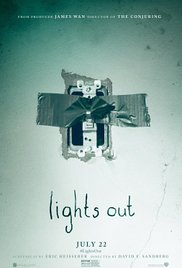 Had “Lights Out” been released after “The Ring,” it might be considered one of the all-time greats of supernatural horror. It has a genuinely creepy (if slight) premise, courtesy of a relentless, unstoppable villain, and several blood-chilling scenes. The film’s biggest problem is that it doesn’t trust its stuff, falling for the cliché trick of needlessly filling the score with crashing, ‘Boo!’ punches of percussion, when the movie was already perfectly scary. Director David F. Sandberg would have been wise to take a page from executive producer James Wan’s “Conjuring” films, and let the camera do the talking, rather than the score.
Had “Lights Out” been released after “The Ring,” it might be considered one of the all-time greats of supernatural horror. It has a genuinely creepy (if slight) premise, courtesy of a relentless, unstoppable villain, and several blood-chilling scenes. The film’s biggest problem is that it doesn’t trust its stuff, falling for the cliché trick of needlessly filling the score with crashing, ‘Boo!’ punches of percussion, when the movie was already perfectly scary. Director David F. Sandberg would have been wise to take a page from executive producer James Wan’s “Conjuring” films, and let the camera do the talking, rather than the score.
Martin (Gabriel Bateman) is concerned for his mother Sophie (Maria Bello). He hears her talking to herself at night, and one night he sees something frightening that he cannot understand. Martin begins falling asleep at school, since he refuses to sleep at night. When Sophie doesn’t answer calls from Child Protective Services after Martin has fallen asleep for the third time in a week, Martin’s adult half-sister Rebecca (Teresa Palmer) picks him up. When Martin tells Rebecca about Sophie’s friend Diana, Rebecca stops in her tracks. Diana was a girl that befriended Sophie when both were under psychiatric care as teenagers. Diana died during an unconventional treatment called light therapy, but in death has latched on to Sophie, moving in the darkness. (Rebecca saw Diana as a child too, but no one believed her.) As Martin and Rebecca learn more about Diana, the more aggressive Diana fights to keep Sophie to herself.
Think of “Lights Out” as a J-horror take on the Doctor Who episode “Blink,” which involves stone statues called Weeping Angels that can move incredibly fast when no one is looking at them. In this case, you can be staring directly at Diana’s shadow across the room, turn on the lights, and watch her disappear. When you turn the lights back on, she can be standing directly in front of you. It’s incredibly unnerving watching her warp across space, to the point where you almost want to keep the lights off just to keep an eye on her and know where she is at all times. Of course, if a character actually did that, they would surely die, and gruesomely at that. There is a Drew Barrymore-esque cameo death in the movie’s first scene, and it’s quite shocking for a PG-13 film.
One “rule” of “Lights Out” that is never nailed down is whether or not there are limitations to Diana’s ability to terrorize the living. Presumably, there are no limitations, as she haunts people in multiple locations, but how does she get around? How does she know where other people live and work? Can she be in more than one place at a time? If Sophie left the house while Diana was terrorizing someone else, would she know? And if not, how would she know where to find Sophie once she returned to the house? Perhaps there’s a psychic link between Diana and Sophie, or perhaps we’re just not supposed to ask these questions.
While the film may have resorted to using to some worn-out, old-school scare tactics (the noisy score), there is one scene that feels like an homage to the late Wes Craven, where Sandberg adds a moment of levity to a terrifying sequence, and it works magnificently. As horror movies have gotten increasingly deathly serious, it’s nice to see a film understand the power of making people laugh shortly after scaring the bejeezus out of them. Speaking of Craven, the acting here is on par with Craven’s early work; no one embarrasses himself, but no one stands out either, largely because the development of the living characters is a distant second to the development of the dead one. If there is a standout, it’s Palmer, who makes Rebecca the most laconic damsel in distress in recent horror memory.
“Lights Out” cost a mere $4.9 million to make, and it looks awfully good for a film with such a small budget. Sandberg shows promise here (and he’s clearly impressed the Warner Bros. brass, as they’ve signed him to direct “Annabelle II”), but next time around, here’s hoping that he gives us at least one human, a living human, to root for.
 (3 / 5)
(3 / 5)
This review originally ran July 21, 2016 on Bullz-Eye.com.



